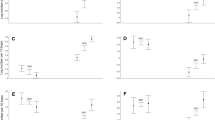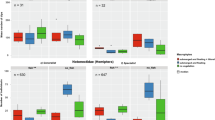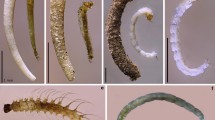Abstract
Hydrologic variability affects the development of predator populations in freshwater marsh systems, with predatory fishes typically predominating in permanently inundated marshes and predatory insects predominating in ephemeral marshes. The ability of larger predatory fishes to control the abundance of small fishes is fairly well understood, whereas control of fish populations by predatory insects has not been well studied. To address this gap in our understanding of marsh food web dynamics, we exposed groups of flagfishJordanella floridae to larvae of the widely distributed dragonflyAnax junius. We also examined how habitat complexity affected the foraging efficiency ofA. junius larvae. Dragonfly larvae reduced survival of flagfish by 40% during a ten-day experiment. Survival rates did not differ between simple and complex habitats. These results suggest that predatory insects could play an important role in regulating populations of small fishes in marsh systems that lack larger predatory fishes. Further, unlike many predatory fishes, there does not seem to be a significant decrease in the foraging efficiency ofA. junius in complex habitats.
Similar content being viewed by others
Literature Cited
Babbitt, K.J., and F. Jordan. 1996. Predation onBufo terrestris tadpoles: effects of cover and predator identity. Copeia 1996:485–488.
Caldwell, J.P., J.H. Thorp, and T.O. Jervey. 1980. Predator-prey relationships among larval dragonflies, salamanders, and frogs. Oecologia 46:285–289.
Cronin, J.T. and J. Travis. 1986. Size-limited predation on larvalRana areolata (Anura: Ranidae) by two species of backswimmer. (Insecta: Hemiptera: Notonectidae). Herpetologica 42:171–174.
Crowder, L.A. and W.E. Cooper. 1982. Habitat structural complexity and the interaction between bluegills and their prey. Ecology 63:1802–1813.
Folsom, T.C. and N.C. Collins. 1984 The diet and foraging behavior of the larval dragonflyAnax junius (Aeschnidae), with an assessment of the role of refuges and prey activity. Oikos 42:105–113.
Formanowicz, D.R., Jr. 1986. Anuran tadpole/aquatic insect predator-prey interactions: tadpole size and predator capture success. Herpetologica 42:367–373.
Gilbert, C.R. and G.H. Burgess. 1981.Jordanella floridae Goode and Bean, flagfish. p. 532.In D. S. Lee, C.R. Gilbert, C.H. Hocutt, R.E. Jenkins, D.E. McAllister, and J.R. Stauffer, Jr. (eds.) Atlas of North American Freshwater Fishes. North Carolina State Museum of Natural History, Raleigh, NC, USA.
Gotceitas, V. 1990. Variation in plant stem density and its effect on foraging success of juvenile bluegill sunfish. Environmental Biology of Fishes 27:63–70.
Gotceitas, V. and P. Colgan. 1989. Predator foraging success and habitat complexity: a quantitative test of the threshold hypothesis. Oecologia 80:158–166.
Heck, K.L., Jr. and L.B. Crowder. 1991. Habitat structure and predator-prey interactions in vegetated aquatic systems, p. 281–299.In S.S. Bell, E.D. McCoy, and H.R. Mushinsky (eds.) Habitat structure: The Physical Arrangement of Objects in Space. Chapman and Hall, New York, NY, USA.
Heyer, W.R., R.W. McDiarmid, and D.L. Weigmann. 1975. Tadpoles, predation and pond habitats in the tropics. Biotropica 7:100–11.
Holomuzki, J.R. 1986. Predator avoidance and diel patterns of microhabitat use by larval tiger salamanders. Ecology 67:737–748.
Kipling, C. and W.E. Frost. 1970. A study of the mortality, population numbers, year class strengths, production and food consumption of pike.Esox lucius L., in Windermere from 1944 to 1962. Journal of Animal Ecology 39:115–157.
Kushlan, J.A. 1976. Environmental stability and fish community diversity. Ecology 57:821–825.
Kushlan, J.A. 1980. Population fluctuations of Everglades fishes. Copeia 1980:870–874.
Loftus, W.F. and A.M. Eklund. 1994. Long-term dynamics of an Everglades small-fish assemblage. p. 461–483.In S.M. Davis and J.C. Ogden (eds.) Everglades: The Ecosystem and its Restoration. St. Lucie Press, Delray Beach, FL, USA.
McCormick, S. and G.A. Polis. 1982. Arthropods that prey on vertebrates. Biological Review (Great Britain) 57:29–58.
McPeek, M.A. 1989. Differential dispersal tendencies amongEnallagma damselflies (Odonata) inhabiting different habitats. Oikos 56:187–195.
Milliken, G.A. and D.E. Johnson. 1992. Analysis of Messy Data: Designed Experiments. Van Nostrand Reinhold. New York, NY, USA.
Morin, P.J. 1984. Odonate guild composition: experiments with colonization history and fish predation. Ecology 65:1866–1873.
Morin, P.J., S.P. Lawler, and E.A. Johnson. 1990. Ecology and breeding phenology of larvalHyla andersonii: the disadvantages of breeding late. Ecology 71:1590–1598.
Pritchard, G. 1965. Prey capture by dragonfly larvae (Odonata; Anisoptera). Canadian Journal of Zoology 43:271–289.
Schoenly, K., R.A. Beaver, and T.A. Heumier. 1991. On the trophic relationships of insects: a food-web approach. American Naturalist 137:597–638.
Skelly, D.K. and E.E. Werner. 1990. Behavioral and life-historical responses of larval American toads to an odonate predator. Ecology 71:2313–2322.
Werner, E.E. 1991. Nonlethal effects of a predator on competitive interactions between two anuran larvae. Ecology 72:1709–1720.
Winer, B.J., D.R. Brown, and K.M. Michels. 1991. Statistical Principles in Experimental Design. McGraw-Hill, New York, NY, USA.
Author information
Authors and Affiliations
Rights and permissions
About this article
Cite this article
Jordan, F., McCreary, A.C. Effects of an odonate predator and habitat complexity on survival of the flagfishJordanella floridae . Wetlands 16, 583–586 (1996). https://doi.org/10.1007/BF03161349
Received:
Accepted:
Issue Date:
DOI: https://doi.org/10.1007/BF03161349




